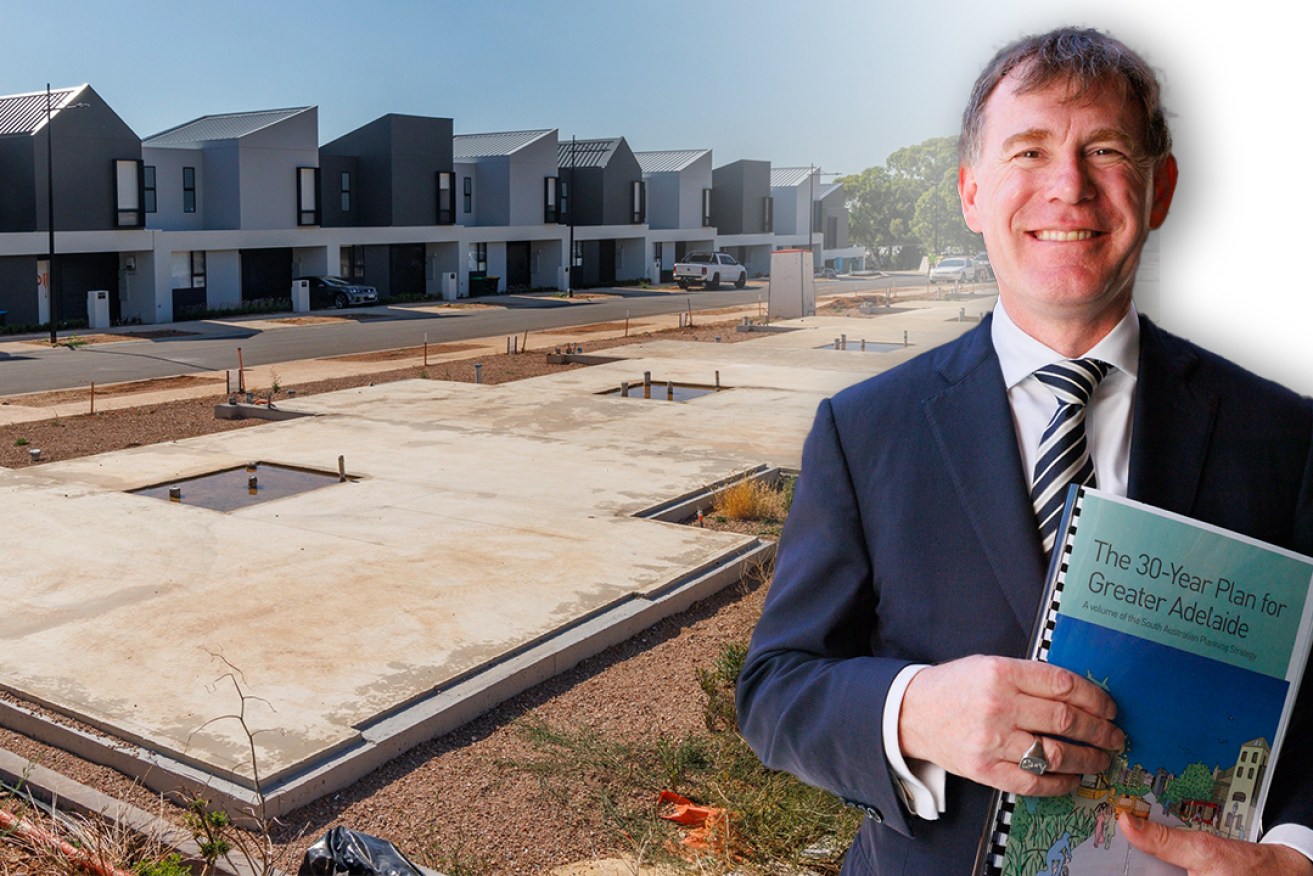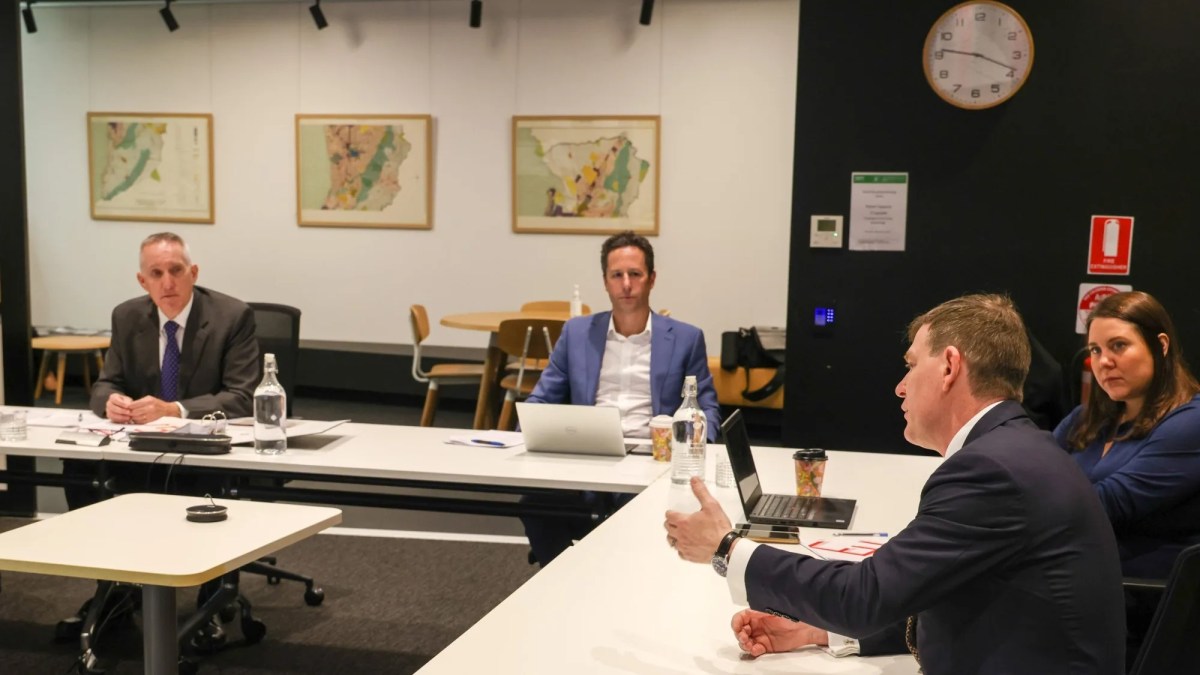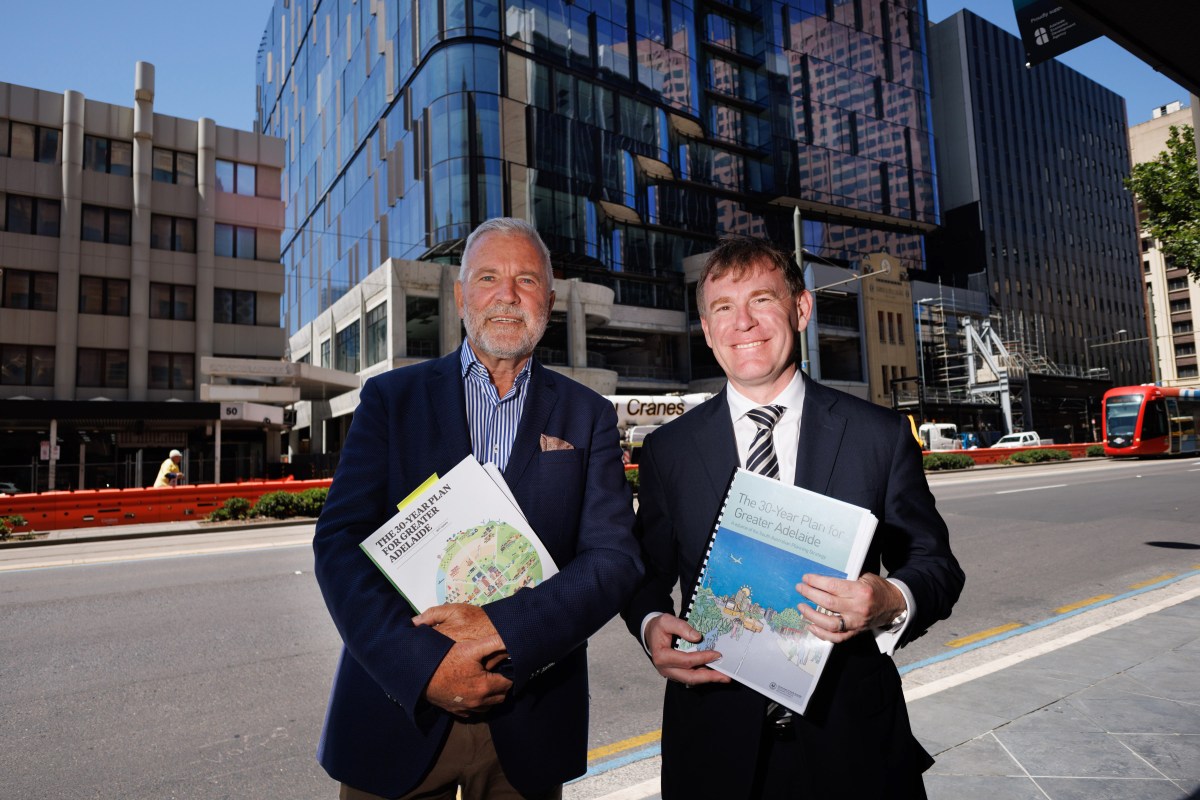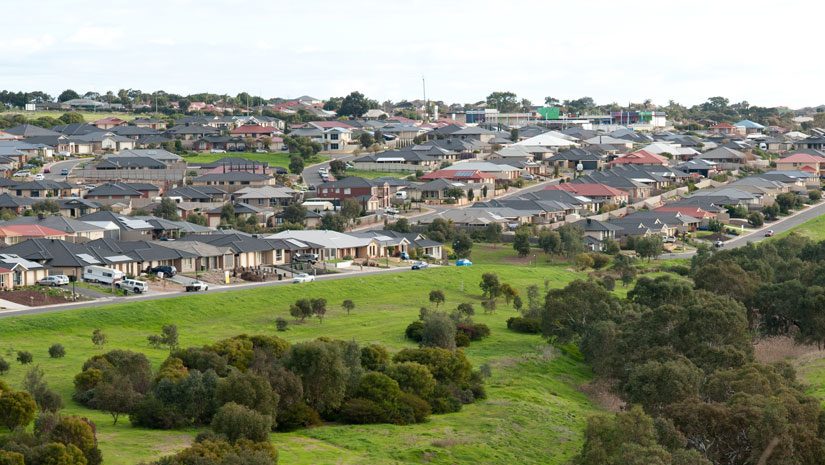SA’s planning minister wants to reshape debate over urban sprawl
Planning Minister Nick Champion believes urban sprawl has become a “whipping boy” in the perennial debate over new housing, and is flagging a shift away from “arbitrary” government targets for infill housing and greenfield development.


Planning Minister Nick Champion. Photos: Tony Lewis/InDaily. Image: Tom Aldahn/InDaily
The Malinauskas Government put Adelaide’s urban sprawl firmly back on the political agenda this week after announcing a move to rezone hundreds of hectares of greenfield land in the outer northern and southern suburbs for residential living.
The land release, slated to create 23,700 homes – more than twice the number of allotments created by the controversial 2010 Mount Barker rezoning – comes at an inflection point for the state’s planning system, which is currently subject to an expert panel review examining contentious issues such as urban infill, heritage, character and trees.
It also comes as the State Planning Commission embarks on the next iteration of the 30-Year Plan for Greater Adelaide – along with six new regional plans – which will map out a planning vision for Adelaide’s urban form until 2053.
In a wide-ranging interview with InDaily this week, Planning Minister Nick Champion signalled a departure from “problematic” targets outlined in previous 30-year plans.
“Previous plans have articulated some percentage infill versus greenfield growth. I think what’s demanded of now is more diversity and choice for families rather than arbitrary targets which are sometimes set by these sorts of plans,” he said.
“But ultimately, it’ll be individuals who decide, it will be families who decide, it will be the market who decides.”
Urban sprawl has been a kind of whipping boy – I don’t think that language helps. People live in these communities, they work, they contribute to society, they’re good communities.
The 30-Year Plan for Greater Adelaide was first released in 2010 and updated in 2017. The most recent edition set six targets to manage Adelaide’s urban growth with a goal of delivering “a more compact urban form” and managing growth “within the existing urban footprint”.
The first target was for 85 per cent of all new housing in metropolitan Adelaide to be built within “established urban areas” by 2045. Adelaide was on track to reach this goal, according to a report card released by the Planning Commission in 2020.
Other 30-Year Plan targets included building 60 per cent of all new housing in “close proximity” to fixed rail public transport and/or high-frequency bus routes, as well as increasing the share of work trips made by active transport by 30 per cent.
Asked if these targets would be axed in the next 30-Year Plan update, Champion said: “I don’t think we want to use that sort of language, but I’m less focused on targets than we are on making sure we’ve got a functional housing market, both now and into the future.”
He later went on to say: “Urban sprawl has been a kind of whipping boy – I don’t think that language helps.”
“People live in these communities, they work, they contribute to society, they’re good communities.”
The comments echo those of Premier Peter Malinauskas, who has said that urban sprawl is “not a dirty word” and Adelaide’s outer metropolitan area should be developed “in a considered way while ensuring infrastructure keeps up”.
Champion did not offer an alternative way of describing urban sprawl, adding only: “I think it’s a pejorative term that really actually comes from the United States.”
“And in Adelaide’s case, the Environment and Food Protection Areas (EFPAs) and other things make sure that we’ve adequately accounted for that.
“So I don’t think it’s a particular challenge for the Planning Commission going forward.”

Planning Minister Nick Champion (right) at a meeting of the expert panel review of South Australia’s planning system last year. Former Urban Development Institute SA president John Stimson (left) is leading the review. Photo: Tony Lewis/InDaily
The minister also said the 30-Year Plan’s 85 per cent established urban areas target for new housing “never got met”, adding that it “goes back to my original commentary about you get these arbitrary targets, and I think they’re problematic”.
“What we’ve got to do is do every bit of that housing market at a much higher quality level in terms of planning – plan better greenfield sites, plan better brownfield sites,” he said.
“You can always do better, and I think we can definitely do better in general infill for instance – there’s a lot of issues out there in the community which have been raised as part of the expert panel.”
General infill – the demolition of old housing stock and replacement with higher density homes – has been a hot topic during the expert panel review, with community concerns about a loss of trees and the strain on parking and existing council infrastructure prompting calls for a rethink of Adelaide’s infill strategy.
Champion attributes these issues, as well as “ad hoc” infill development, to a lack of strategic planning by some metropolitan councils, who he refused to name.
“I think one of the issues around general infill is that there are some councils which are doing the strategic planning to accommodate for that and to talk to the community,” he said.
“Mitcham Council have just recently gone through this and set out where they want growth and density and where they don’t.
“Now some councils have not done that, and they need to do it.
“I won’t name them on this occasion… because I don’t think that’s productive, but I think anybody who’s driving around the city can probably tell.
“Councils actually have a vital role in the strategic planning space… and this (the new 30-Year Plan) is a big opportunity, just as the expert panel was a big opportunity, but they have to step up to the plate.”

State Planning Commission chair Craig Holden and Planning Minister Nick Champion. Photo: Tony Lewis/InDaily
The backlash to general infill in Adelaide’s inner suburbs has also prompted calls, most vocally from the state’s urban development lobby, for a greater focus on strategic infill, greenfield developments and master-planned communities, such as those in Mount Barker, Brompton, Bowden, Lightsview and the old Football Park site at West Lakes.
There’s often a lot of, if you like, standard-setting up amongst the big master planned greenfield sites, and I think people are attracted to that – that’s why there’s a market for it.
According to a 2021 PlanSA report, strategic infill contributed 30 per cent of all net dwelling increases in Greater Adelaide from 2010 to 2019.
That is below general infill, which accounted for 37 per cent of new dwellings during this period, while greenfield sites only contributed 19 per cent.
In gross terms, 49,600 new general infill dwellings were constructed from 2010 to 2019, compared to 22,600 strategic infill dwellings.
Numerous studies have outlined that governments bear a bigger infrastructure cost for greenfield developments than infill in established urban areas.
A 2017 paper by University of South Australia researcher Cathryn Hamilton and University of Adelaide urban planning professor Jon Kellett found the government infrastructure cost of supporting 4000 dwellings on a greenfield site in Playford was between $29,044 and $34,044 per dwelling, compared to just $2451 per dwelling for infill housing at Bowden.
Similarly, a 2014 study by InfraPlan, the predecessor to AI property analytics firm PointData, found the average cost of infrastructure for greenfield development on Adelaide’s northern fringe was $80,500 per lot, compared to $20,000 per net dwelling for general infill in Adelaide.
But Champion argues that greenfield development, along with strategically planned infill similar to Bowden, provides a better opportunity to preserve and enhance amenity.
“It is certainly easier for a greenfield developer who often have a lot of control, they often have a lot of caveats over their property about how your property will look,” Champion said.
“There’s often a lot of, if you like, standard-setting up amongst the big master-planned greenfield sites, and I think people are attracted to that – that’s why there’s a market for it.
“Private developers do it as well because it’s an attractive way of marketing your product, the houses in this case, and people want to live in kind of nice, orderly, well-planned communities.”
The role of public transport in Adelaide’s growth

Houses on Adelaide’s suburban fringe. Photo: Nat Rogers/InDaily
Transport Minister Tom Koutsantonis has already signalled that major public transport projects, such as an extension of the tram network, are not on the government’s agenda.
The lack of planned extensions to Adelaide’s fixed rail passenger network begs the question of whether the 2017 goal to build 60 per cent of Adelaide’s new housing within close proximity to public transport is still a target on the government’s radar.
Asked how public transport would fit into the next 30-Year Plan for Greater Adelaide, especially given the $15 billion investment in the North-South Corridor, Champion highlighted previous government investments in public transport.
“It’s a good question, but one shouldn’t forget that we had pretty big investments in the O-Bahn, we had very big investments in electrification of the Seaford line, and the northern [Gawler] line’s just been electrified,” he said.
“The car [has] been dominant since the 1930s as a method of transportation. We’re now seeing the electrification of that. Even though we will see a dip in people using cars, they’re still going to be present in our society in one form or another.
“We do need to I think look at models of precinct parking and the like, I think that would be useful in some of these development to make sure you’ve got enough parking (for visitors and residents).
“So, yes to transport-orientated developments, but we’ve got to learn some lessons about what happened in the past and apply those lessons.”
Asked whether car dependency would be something that would be an accepted feature of South Australia’s future planning, Champion said: “It gets back to this diversity and choice, and people are going to want to have different lives at different times.”
“The important thing is not to choose for other people, not for the government to sort of wag its finger at people so much as to allow them to choose in a functioning market.
“I think we’ve all lived in different circumstances and seen that sometimes you have to use your car and sometimes you can use the train.”
State Planning Commission chair Craig Holden, who is leading the consultation on the new 30-Year Plans, said the suburbs running along the electrified southern and northern train lines would be a central focus for potential rezoning.
“They’re obvious nodes to make use of that huge capital investment with some greater densities,” Holden said.
“Perhaps Elizabeth town centre could do with a regeneration. We’ll look at and talk to those communities, about how we could develop closer to those train lines and how that could be more utilised.”
The state government has set aside $3.6 million for the State Planning Commission to undertake the next round of 30-year plans.
A discussion paper on the 30-Year Plan for Greater Adelaide is set to be released for consultation in May ahead of the final plan being developed in 2024.
Tomorrow, InDaily examines the merits of the state government’s push to create 23,700 new homes in Hackham, Sellicks Beach, Dry Creek and Concordia.




